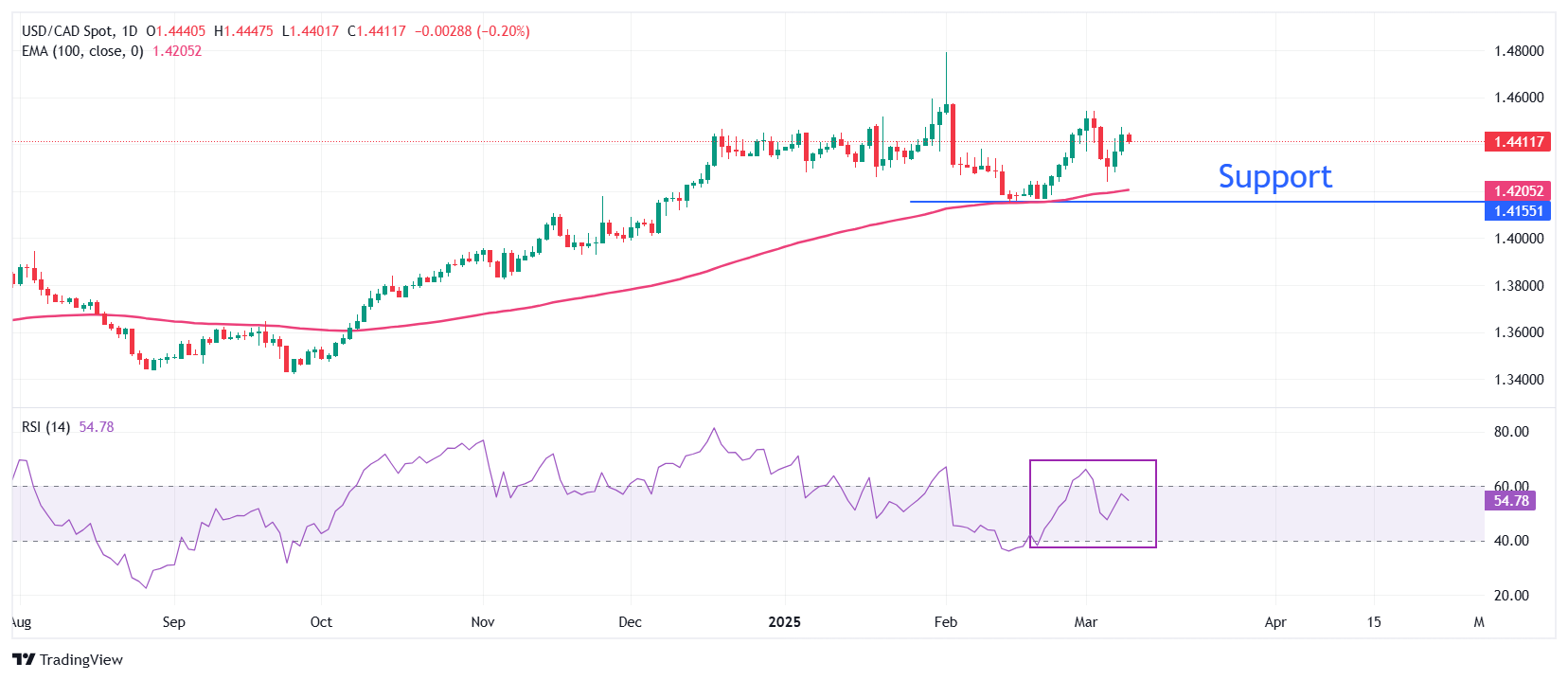USD/CAD Price Forecast: Trades lower amid caution ahead of BoC monetary policy meeting
- USD/CAD slides to near 1.4400 amid weakness in the US Dollar.
- US President Trump’s tariff agenda has prompted uncertainty over the US economic outlook.
- The BoC is expected to cut its borrowing rates by 25 bps to 2.75% on Wednesday.
The USD/CAD pair declines to near 1.4400 in European trading hours on Tuesday after correcting from the four-day high of 1.4470 posted on Monday. The Loonie pair weakens as the US Dollar (USD) underperforms across the board amid fears that the United States (US) could face economic turbulence in the near term due to President Donald Trump’s ‘America First’ policies.
Donald Trump’s tariff agenda is expected to increase input costs for US business owners, which they will pass on to consumers. Such a scenario would result in a decline in households’ purchasing power, diminishing the overall demand.
The US Dollar Index (DXY), which gauges the Greenback’s value against six major currencies, slumps to near 103.35, the lowest level seen in four months.
Meanwhile, the Canadian Dollar (CAD) has been underperforming for over a month as Trump has imposed 25% tariffs on Canada but has provided a one-month exemption on goods that come under the United States-Mexico-Canada Agreement (USMCA).
On Wednesday, investors will focus on the Bank of Canada’s (BoC) monetary policy decision. Analysts at Citi expect the BoC to cut interest rates by 25 basis points (bps) to 2.75% as Trump tariffs have intensified fears of a recession.
USD/CAD holds above the 100-period Exponential Moving Average (EMA), which is around 1.4200, suggesting that the overall trend is bullish.
The 14-period Relative Strength Index (RSI) oscillates in the 40.00-60.00 range, suggesting a sideways trend.
Going forward, an upside move above the March 10 high of 1.4470 will open the door toward the psychological resistance of 1.4500 and the January 30 high of 1.4595.
On the contrary, a breakdown below the February 14 low of 1.4151 by the pair would expose it to the December 9 low of 1.4094, followed by the December 6 low of 1.4020.
USD/CAD daily chart

Canadian Dollar FAQs
The key factors driving the Canadian Dollar (CAD) are the level of interest rates set by the Bank of Canada (BoC), the price of Oil, Canada’s largest export, the health of its economy, inflation and the Trade Balance, which is the difference between the value of Canada’s exports versus its imports. Other factors include market sentiment – whether investors are taking on more risky assets (risk-on) or seeking safe-havens (risk-off) – with risk-on being CAD-positive. As its largest trading partner, the health of the US economy is also a key factor influencing the Canadian Dollar.
The Bank of Canada (BoC) has a significant influence on the Canadian Dollar by setting the level of interest rates that banks can lend to one another. This influences the level of interest rates for everyone. The main goal of the BoC is to maintain inflation at 1-3% by adjusting interest rates up or down. Relatively higher interest rates tend to be positive for the CAD. The Bank of Canada can also use quantitative easing and tightening to influence credit conditions, with the former CAD-negative and the latter CAD-positive.
The price of Oil is a key factor impacting the value of the Canadian Dollar. Petroleum is Canada’s biggest export, so Oil price tends to have an immediate impact on the CAD value. Generally, if Oil price rises CAD also goes up, as aggregate demand for the currency increases. The opposite is the case if the price of Oil falls. Higher Oil prices also tend to result in a greater likelihood of a positive Trade Balance, which is also supportive of the CAD.
While inflation had always traditionally been thought of as a negative factor for a currency since it lowers the value of money, the opposite has actually been the case in modern times with the relaxation of cross-border capital controls. Higher inflation tends to lead central banks to put up interest rates which attracts more capital inflows from global investors seeking a lucrative place to keep their money. This increases demand for the local currency, which in Canada’s case is the Canadian Dollar.
Macroeconomic data releases gauge the health of the economy and can have an impact on the Canadian Dollar. Indicators such as GDP, Manufacturing and Services PMIs, employment, and consumer sentiment surveys can all influence the direction of the CAD. A strong economy is good for the Canadian Dollar. Not only does it attract more foreign investment but it may encourage the Bank of Canada to put up interest rates, leading to a stronger currency. If economic data is weak, however, the CAD is likely to fall.


